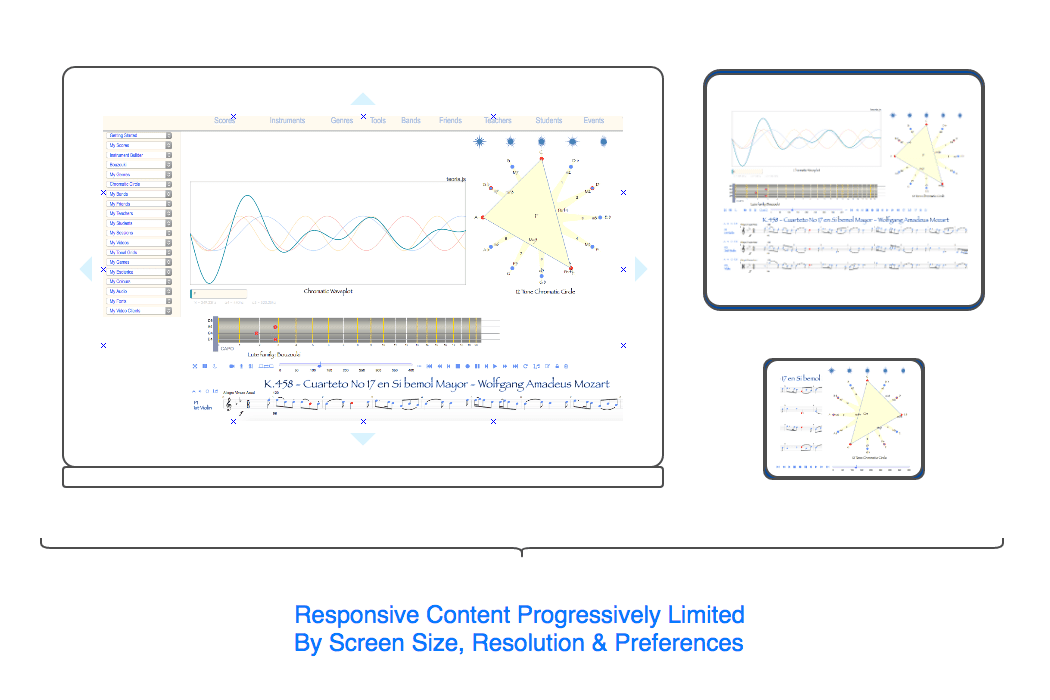Based on generic instrument and music theory tool family models, the idea of wide-ranging interactive musical modeling, or music visualization, is at last coming within reach.
Interactive Musical Modeling: Potential
The most compelling immediate potential benefit of Interactive Musical Modeling is in establishing instrumental and theory tool freedom of choice, which, well implemented, translates into immediacy, independence, diversity and tight integration.
Other compelling aspects of potential are laid out graphically below.
So though sure at some point to fall under the radar of teachers and learners, universities, professional musicians, and inventors across a dozen or more related disciplines, my primary interest here are the dramatically rising number of the marginalized - those who, with no secure income, are ever more critically dependent on social currency and a cultural passport.
In these divisive times, a flowering of cross-cultural understanding and communication seems long overdue. A music visualization aggregator platform opens many new means of generating social value, of serving the often existential needs of the marginalized.
That said, strategy is more a matter of clarity of focus than chasing every whim, so let's try to give all this a little structure.
Following the incremental buildup in sophistication of music learning platforms, what key capabilities does each bring, and where can we draw the line between the existing and untapped potential?
It seems in the nature of this topic that each new blog post bring fresh insights. That these should come so easily speaks volumes over the potential. Now let's try to give some of these avenues of social value generation a face.
Big, brave, open-source, non-profit, community-provisioned, cross-cultural and fruitcake crazy. → Like, share, back-link, pin, tweet and mail. Hashtags? For the crowdfunding: #VisualFutureOfMusic. For the future live platform: #WorldMusicInstrumentsAndTheory. Or simply register as a potential crowdfunder..
Potential
Keywords
online music learning,
online music lessons
distance music learning,
distance music lessons
remote music lessons,
remote music learning
p2p music lessons,
p2p music learning
music visualisation
music visualization
musical instrument models
interactive music instrument models
music theory tools
musical theory
p2p music interworking
p2p musical interworking
comparative musicology
ethnomusicology
world music
international music
folk music
traditional music
P2P musical interworking,
Peer-to-peer musical interworking
WebGL, Web3D,
WebVR, WebAR
Virtual Reality,
Augmented or Mixed Reality
Artificial Intelligence,
Machine Learning
Scalar Vector Graphics,
SVG
3D Cascading Style Sheets,
CSS3D
X3Dom,
XML3D
Thursday, March 9, 2017
Music Visualisation (Interactive Musical Modeling): Potential
Finger exercises ease motor skills development, often in the context of learning a specific piece. But what of musical understanding? Directly linking abstract theory with exercise notation and instrument display have the potential to dramatically speed development of underlying music-cultural fluency. Moreover, at the low speeds suited to building understanding, resource loads are very modest.
Live-streamed, on-demand musical individualism is on the rise. Progressively exploiting the full spectrum of world music tool and instrumental configurations, could musical learning gaps also be filled? Until now, there has been no supporting remote teaching toolset. Can we globally connect the musical virtuoso with the learner? Can we match the diverse, little-known and enlightening with the motivated, the curious and the marginalised? Could we deliver a new wave of grass-roots musical empowerment? We think so.

 Score Analysis: Practice Optimisation
Score Analysis: Practice Optimisation
 Gamification
Gamification Modal Landscapes Comparison
Modal Landscapes Comparison Embeddable Instruments & Tools
Embeddable Instruments & Tools Reusable Framework
Reusable Framework Responsive Content
Responsive Content Instruments and Theory Tools
Instruments and Theory Tools Genre Timeline Maps
Genre Timeline Maps Potential Usage Scenarios
Potential Usage Scenarios Multiple Visualizations
Multiple Visualizations Microtonal Notations
Microtonal Notations
 Diversity Engine
Diversity Engine Notation Or Audio
Notation Or Audio Music Font Compatibility Matrix
Music Font Compatibility Matrix Fretboard Or Fingerboard
Fretboard Or Fingerboard Instruments and Theory Tools
Instruments and Theory Tools
Comments, questions and (especially) critique welcome.